Gender-Based Disparities in Technical Education Assessment and Certification Outcomes Across Philippine Regions: A Regional Perspective
DOI:
https://doi.org/10.69569/jip.2025.561Keywords:
Assessment outcomes, Gender gap, Regional disparities, TVET certificationAbstract
This study investigates gender-based disparities in assessment and certification outcomes within the Philippine technical vocational education system by analyzing 3,030,892 candidates—1,609,060 males and 1,421,832 females—across 17 regions and the Central Office in the year 2024. While national data suggest general gender parity in Technical and Vocational Education and Training (TVET), regional-level disparities remain underexplored. Using a descriptive-comparative quantitative design and secondary data from publicly available reports, the study assessed regional certification rates and calculated gender gaps. Results revealed that the National Capital Region recorded the highest certification rates for both males (97.48%) and females (98.01%). At the same time, Region X exhibited the widest gender gap at -18.81%, with males significantly underperforming compared to females. Region I demonstrated near gender parity with only a 0.23% difference. These findings underscore the uneven distribution of TVET success across areas, shaped by socio-economic, institutional, and gender-specific factors. The study highlights the need for localized, gender-responsive interventions, including improved training access, targeted support for underperforming groups, and stronger regional implementation of national TVET equity policies to ensure inclusive skills development across the country.
Downloads
References
Alinea, J. M. (2022). Mapping the gender gaps in TVET practices: A literature review. Interdisciplinary Research Review, 17(2), 47–53. Retrieved from https://tinyurl.com/2w44fufu
Asian Development Bank. (2014). Gender equality in the labor market in the Philippines. https://tinyurl.com/227sj9x8
Atchoarena, D., & Delluc, A. (2001). Revisiting technical and vocational education in Sub-Saharan Africa: An update on trends, innovations, and challenges. International Institute for Educational Planning/UNESCO. https://unesdoc.unesco.org/ark:/48223/pf0000129354
Eccles, J. S., & Wigfield, A. (2002). Motivational beliefs, values, and goals. Annual Review of Psychology, 53, 109–132. https://doi.org/10.1146/annurev.psych.53.100901.135153
International Labour Organization. (2019). Skills and jobs mismatches in low- and middle-income countries. International Labour Office. https://tinyurl.com/4ytbzkef
Karp, D. R., Carlin, S., Cook-Deegan, R., Ford, D. E., Geller, G., Glass, D. N., Greely, H., Guthridge, J., Kahn, J., Kaslow, R., Kraft, C., Macqueen, K., Malin, B., Scheuerman, R. H., & Sugarman, J. (2008). Ethical and practical issues associated with aggregating databases. PLoS medicine, 5(9), e190. https://doi.org/10.1371/journal.pmed.0050190
King, K., & Palmer, R. (2010). Planning for technical and vocational skills development. UNESCO. https://unesdoc.unesco.org/ark:/48223/pf0000189530
Lent, R. W., & Brown, S. D. (2013). Social cognitive model of career self-management: Toward a unifying view of adaptive career behavior. Journal of Counseling Psychology, 60(4), 557–568. https://doi.org/10.1037/a0033446
Maclean, R., & Wilson, D. (2009). International handbook of education for the changing world of work: Bridging academic and vocational learning. Springer Science & Business Media. http://dx.doi.org/10.1007/978-1-4020-5281-1
Masud, R., Mutalib, A. A., & Ismail, I. (2018). Gender inequality: A comparative study of participation in technical courses. Journal of Counseling and Educational Technology, 1(1), Article 10. https://doi.org/10.32698/0121
Ruggiano, N., & Perry, T. E. (2019). Conducting secondary analysis of qualitative data: Should we, can we, and how? Qualitative Social Work, 18(1), 81–97. https://doi.org/10.1177/1473325017700701
Saunders, M. N. K., Lewis, P., & Thornhill, A. (2023). Research methods for business students (5th ed.). Pearson Education. https://tinyurl.com/5yhz4uc7
Technical Education and Skills Development Authority. (2023). Annual TVET statistics 2023. https://tinyurl.com/ywzarkrt
Technical Education and Skills Development Authority. (2024a). TVET fact sheet (2019–2023). https://tinyurl.com/yn3kna4t
Technical Education and Skills Development Authority. (2024b). 1st quarter TVET statistics [PDF]. TESDA. https://tinyurl.com/32x5d5tj
Technical Education and Skills Development Authority. (2024c). 2nd quarter TVET statistics [PDF]. TESDA. https://tinyurl.com/ytw7yh3j
Technical Education and Skills Development Authority. (2024d). 3rd quarter TVET statistics [PDF]. TESDA. https://tinyurl.com/v4vp334
Technical Education and Skills Development Authority. (2024e). 4th quarter TVET statistics [PDF]. TESDA. https://tinyurl.com/ykjpn8zj
Technical Education and Skills Development Authority Gender and Development Plan. (2023). Annual gender and development plan and budget FY 2023. https://twc.tesda.gov.ph/_gad/files/GPB2023.pdf
TESDA Women’s Center. (2025). About the TESDA women’s center. https://twc.tesda.gov.ph
Tripathy, J. P. (2013). Secondary data analysis: Ethical issues and challenges. Iranian Journal of Public Health, 42(12), 1478–1479. https://www.ncbi.nlm.nih.gov/pmc/articles/PMC4441947/
UNESCO-UNEVOC. (2013). Promising practices in TVET for women. United Nations Educational, Scientific, and Cultural Organization. https://tinyurl.com/tfxhthxz
UNESCO-UNEVOC. (2022a). Boosting gender equality in science and technology: A challenge for TVET programmes and careers. UNESCO-UNEVOC International Centre for Technical and Vocational Education and Training. https://tinyurl.com/mpzf25fw
UNESCO-UNEVOC. (2022b). Transforming technical and vocational education and training for the future: UNESCO strategy for TVET 2022–2029. https://tinyurl.com/yc7fyk9u
United Nations. (2015). Transforming our world: The 2030 agenda for sustainable development. https://sdgs.un.org/2030agenda
Downloads
Published
How to Cite
Issue
Section
License
Copyright (c) 2025 Journal of Interdisciplinary Perspectives

This work is licensed under a Creative Commons Attribution-NonCommercial 4.0 International License.








